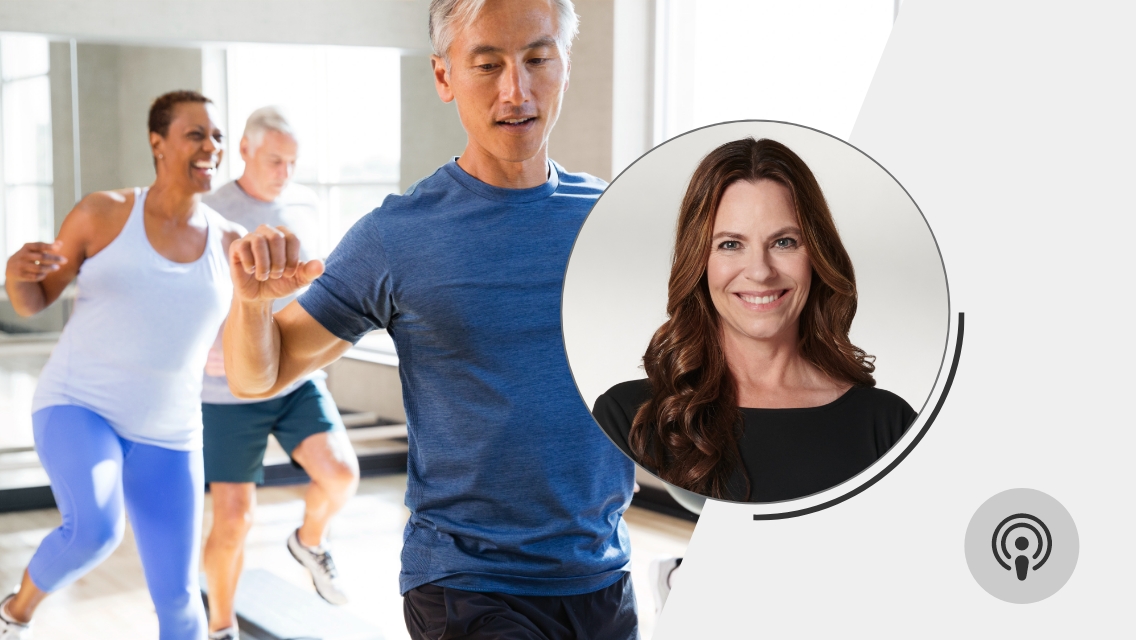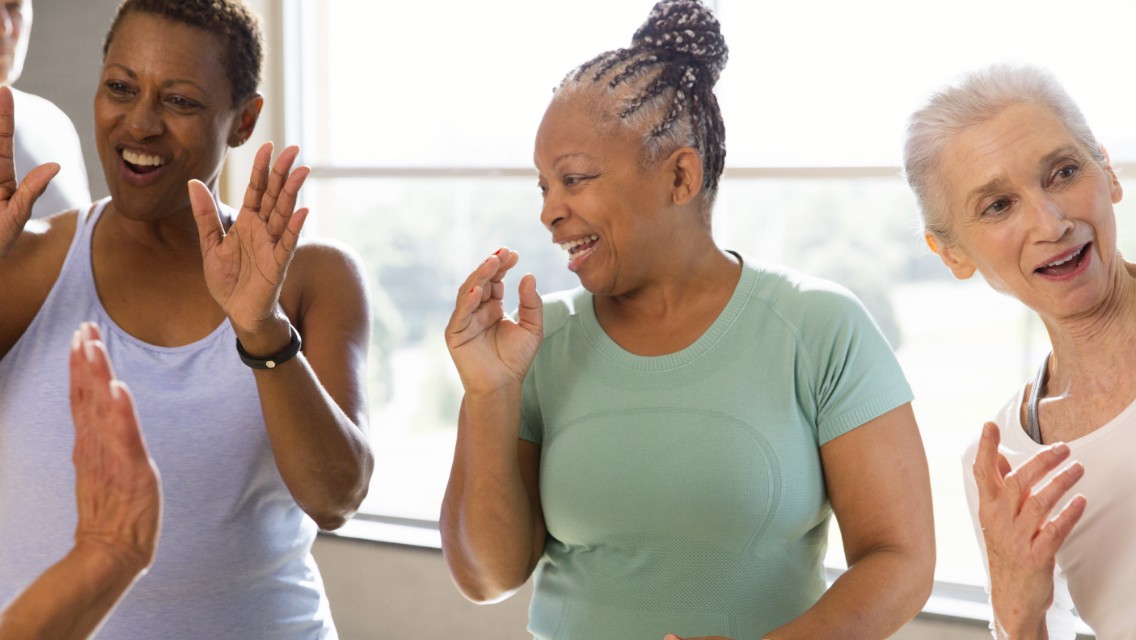Maintaining muscle strength and good balance is essential for health and function as we age — as is engaging in regular movement in general. Our muscle mass and sense of equilibrium often naturally decline as the years pass, but with intentional training, we can stimulate muscle growth and reduce the risk of falling or conditions of frailty.
“We are constantly developing new programs to benefit our ARORA community, especially when it comes to improving strength, mobility, and balance,” says Wes Robertson, studio and signature programming leader for Life Time. “We saw the need for a program that would provide more personal, direct coaching for these goals in a small-class-size environment — so we created a new signature group training format called ARORA Fit.”
To give you an idea of what to expect in this class, we spoke with Robertson and Rob Glick, senior director of group fitness programming for Life Time, the two of the designers of the format.
Life Time Editorial | Can you give us a high-level overview of the ARORA Fit program?
Rob Glick | ARORA Fit is a 45- to 60-minute small-group training class that focuses on exercises for strength, coordination, balance, and mobility. These efforts, done appropriately, are ones that are specifically vital to continuing an active and vibrant lifestyle. They are especially beneficial to those aged 65 and older — although we welcome anyone, at any age.
In this format, participants work with the coach who’s leading the class to get just the right dose of training to see consistent progression, with an emphasis on safety and fall prevention. Each class has an average of seven to eight participants.
LTE | Why is training for strength, mobility, and balance essential for health, particularly as we age?
RG | For so many reasons. Let’s start with strength training, which helps increase metabolism, movement quality, and confidence, as well as counteracts the natural muscle loss that occurs in our adult and older-adult years. Weight-bearing and resistance exercises can also lead to stronger bones. When the ligaments that attach muscles to bones gently pull against the periosteum of the bone (the outer covering of bone tissue) during contraction, it causes bones to become denser, which makes them less likely to break even after a fall.
Training for balance and mobility helps with better coordination, a reduced risk of falling, and improving reaction times, which tend to get slower as we get older. Exercise can help speed up reaction times by strengthening muscles, which encourages them to perform more quickly. For example, if someone starts to fall, a faster reaction time helps them stay upright by quickly putting a hand on a wall or grabbing onto something stable.
Fitness in general also helps with many aspects of our health, such as brain function and sleep. People who exercise regularly are known to have better overall brain function. Exercise promotes the release of certain neurotransmitters that help keep the brain healthy even during times of stress. The clearer thinking that comes from regular exercise can help people navigate more effectively through complex situations.
Getting plenty of movement also helps you sleep more soundly, which is important for those who struggle with disrupted sleep patterns — a common complaint of older adults. Exercise helps you maintain a healthy circadian rhythm, allowing for better sleep and less foggy thinking and irritability.
LTE | What can you tell us about the ARORA Fit coaches?
RG | All of trainers and instructors have national training certifications. Most of our them are certified through National Academy of Sports Medicine (NASM). Our ARORA Fit coaches also have Life Time’s ARORA personal-training certification.
(Learn more: “Aging Active and Fit: Introducing ARORA-Certified Personal Training.”)
Throughout class, our coaches actively help participants with execution, alignment, and technique for each exercise. We always strive to ensure the ARORA Fit group understands the “what, how, and why” of everything we do in class.
LTE | Is ARORA Fit designed for a specific audience?
RG | Although anyone is welcome to take our ARORA Fit classes, we designed this format for those who are new to strength training, coming back from an injury, or are part of our ARORA community at Life Time.
LTE | What types of exercises and equipment will you see in a typical ARORA Fit class?
Wes Robertson | We designed ARORA Fit to focus on moves that simulate real-life actions. You’ll see basic strength-training exercises that incorporate squatting for the lower body, pulling and pushing for the upper body, and rotating from the core. For example, one class could incorporate lunges, pushups, bicep curls, and balancing exercises on a BOSU ball — all followed by a cool-down and full-body stretch routine.
Coaches program the class to include movements in the categories of strength, coordination, and balance, spending equal time in each area. Neuroplasticity drills are also part of every class. You’ll work through crossbody movement patterns and activities to benefit cognitive functioning.
ARORA Fit takes place in the functional area of the workout floor or in our dedicated Signature Group Training space, so participants use steps, dumbbells, kettlebells, TRX suspension straps, and bands, along with various equipment for low-impact cardio training.
LTE | What are the benefits of working out in a small group? Do you recommend sticking with a regular class day and time?
WR | A smaller class size allows for more individualized attention from your coach, and for the exercises to be better tailored to your specific needs and abilities. Plus, your small group starts to feel like a team, and it’s easy for everyone to become fast friends.
It’s great to stick with working out with the same group for camaraderie, though it is not required. Consistency is most important, so get to class whenever it’s possible for you each week.
LTE | ARORA Fit is taught in a group setting. Are coaches able to scale up or scale back the workout depending on the individual?
RG | Absolutely. ARORA Fit coaches can customize the workout to fit each person’s fitness, balance, and coordination levels to provide just the right amount of challenge. And as they improve, the workouts change to help them continue making progress.
LTE | How would you recommend fitting ARORA Fit into your routine? Are there other ARORA classes that complement this format?
RG | It would be great if you could get to an ARORA Fit class twice per week for some strength training, balance, and mobility work. Outside of that, I recommend at least three days per week of cardio training, such as walking or indoor cycling.
Any of our ARORA formats that focus on cardiovascular training would be a great compliment. Try ARORA Aqua, ARORA Cycle, ARORA Walking Club, ARORA Dance, or ARORA Total Body.
LTE | If someone is interested in trying ARORA Fit, how can they get started?
RG | If you’re a Life Time Signature Member, unlimited signature group training classes are complimentary to you (this includes ARORA Fit, GTX, Alpha, and Ultra Fit). Check the schedule to see if ARORA Fit is available at your club.
Not currently a Signature Member? Connect with your club’s Studio Leader for a complimentary ARORA Fit trial.
Not currently a Life Time member? Learn more about the Signature Membership here.





